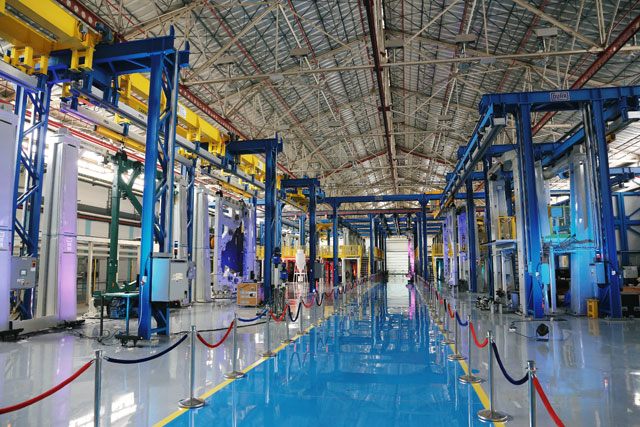The Israeli Air Force (IAF) has accelerated its preparations for the delivery of the first Lockheed Martin F-35I Adir at the end of the year.
The "Golden Eagle" squadron at the Nevatim airbase is working to be ready for the stealth fighter that in Israel is considered one of the main elements of the edge the IAF wants to have in any future war.
Major Ehud is the F-35 squadron project manager in charge of the preparations. He said the deployment of the F-35 in the IAF is no less than a revolution. "With its capabilities, it redefines the term multi-role aircraft,” Ehud says.
"We know even before the first aircraft lands in this base that it's a force multiplier. Two F-35s will do the work of larger formations, sometimes of different types. Its capabilities to locate targets and perform the best attack under different conditions are no less than an operational revolution.”
In a slightly different way, the F-35 also revolutionises how frontline fighters are maintained. In the US joint programme office’s concept, overseas maintenance work will be consolidated at regional hubs in Europe and the Pacific. For Israel, however, that strategy always seemed in conflict with the air force’s insistence on as much freedom as possible from foreign suppliers.
In recent years, since the first contract for the purchase of the F-35 was signed, the IAF has decided only subsystems of the F-35 may be sent for maintenance and repair in special centres abroad.

IAI's Lahav division is set to produce 811 pairs of F-35 wings over 10 years
Israel Aerospace Industries
"We have made it clear the maintenance of the aircraft, including depot level, will be done in our bases”, an IAF senior officer told Flight. He added, even subsystems will be sent to other countries only if "there is a technical reason”.
The preparations for the deployment of the F-35 include the establishment of a combined simulator centre in the IAF's Nevatim air base. "Part of the simulation centre already operates and we plan to complete it by the end of the year,” the officer says.
IAF fighter pilots have begun training on the F-35 at bases in the USA. These pilots will be the first to fly the aircraft in Israel and will instruct the others as more aircraft are delivered.
When the IAF decided to purchase the F-35, it made clear the preferred configuration will include an Israel-developed electronic warfare system, replacing the BAE Systems ASQ-239 Barracuda. This request was not accepted by Washington, but there are indications that after the stealth fighter arrives in Israel, “add-on" subsystems will be installed to give it the needed "special edge" based on the vast operational experience of the IAF in the Middle East.
The Israeli F-35s will also carry a unique communication system in the cockpit. The additional box will allow the F-35s to integrate with Israel’s recently deployed airborne network, which Rafael calls Ravnet-300 on the export market. Though in some ways comparable to the NATO-standard Link 16 system, Ravnet-300 operates significantly faster and allows more applications.
In December a contract for the purchase of another 14 Lockheed Martin F-35 (Adir) fighters for the IAF was signed in Washington.
The IAF and the ministry of defence wanted to purchase 31 F-35s but strong opposition in the Israeli cabinet limited the number in the new $2.82 billion deal. Instead, the new contract includes options for an additional 17 examples.
In 2010, Israel had already signed a deal to purchase 19 of the fighters.
Defence ministry sources say efforts will continue to purchase the additional number of the stealth aircraft that match the operational needs of the IAF.
The original plan was to deploy 75 F-35Is, replacing an ageing fleet of F-16A/Bs. Recent political dynamics could bolster the air force’s plans to buy more of the fighters. Last year, the Obama administration accepted terms on a nuclear deal with Iran over the objections of the Israeli government. In return, Tel Aviv expects to receive a “compensation package” from the US government. Indications suggest such a package will increase the number of F-35Is sold to Israel, perhaps nearing the air force’s original procurement plan.
In addition to the communications and maintenance deals, Israeli industry also stands to benefit from the F-35I acquisition. As part of the industrial co-operation agreements included in the two contracts signed so far, Israel Aerospace Industries (IAI) is supplying wings for the F-35A, and a joint venture that includes Elbit Systems is providing the special pilot helmet.
IAI’s highly automated wing manufacturing line is scheduled to produce more than 811 pairs of F-35 wings over the next decade, rising to a production rate of four per month by the end of the year.
The Lahav division of IAI has in the past manufactured wings for the Lockheed Martin F-16 fighter aircraft and the USAF’s Northrop T-38C Talon trainers, as well as major assemblies for other aircraft and customers.
Israel has not joined the F-35 multinational program as a full partner, but has been trying to get manufacturing contracts as part of the industrial co-operation agreement that is part of every deal of this nature.
If more contracts are signed, the Israeli ministry of defence plans to increase the volume of parts and systems for the F-35 that will be manufactured in Israel.
Source: FlightGlobal.com
















